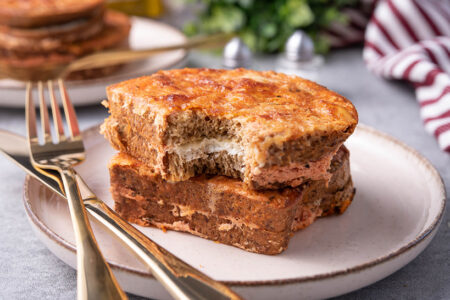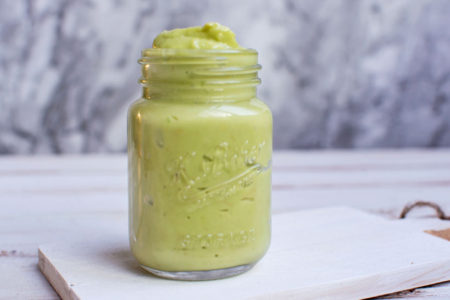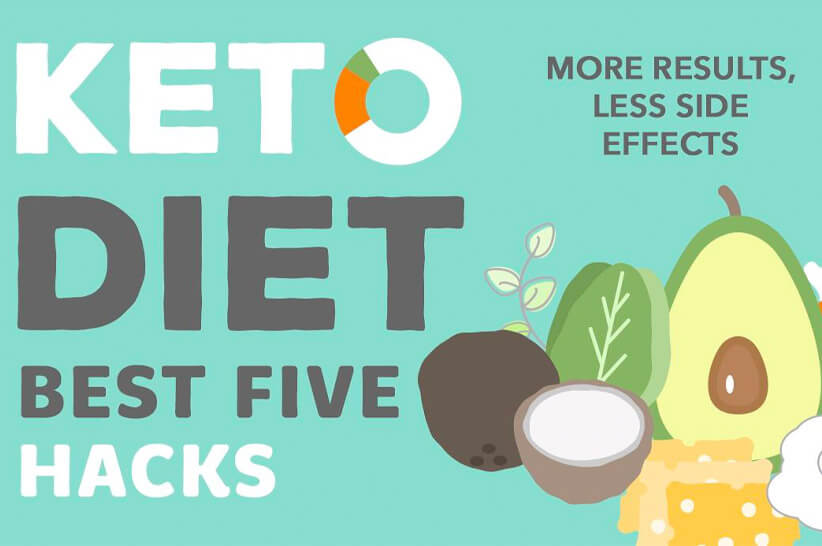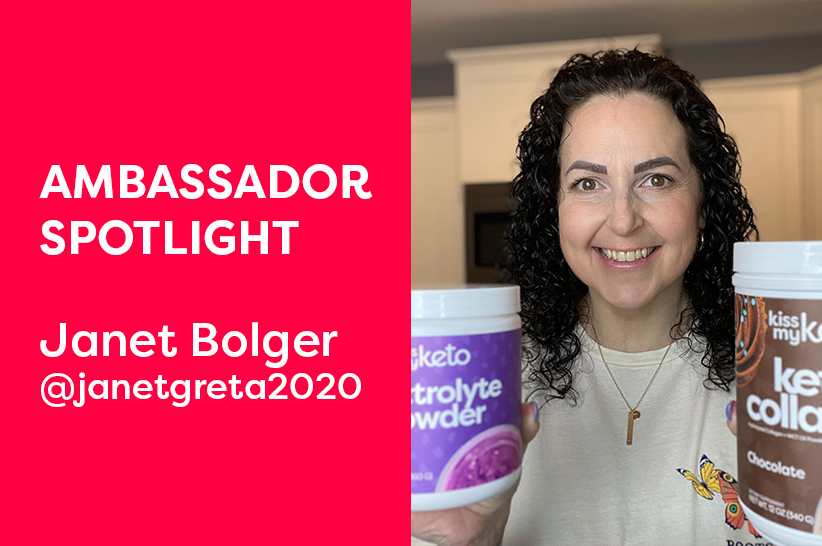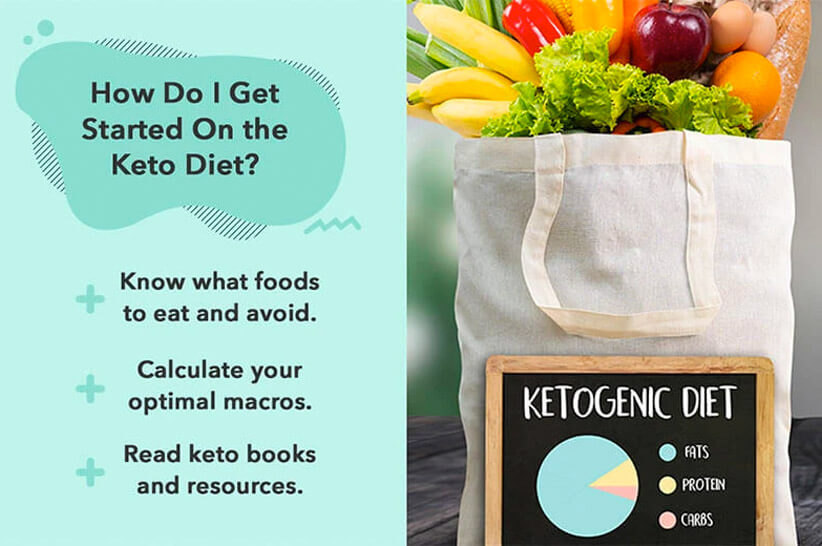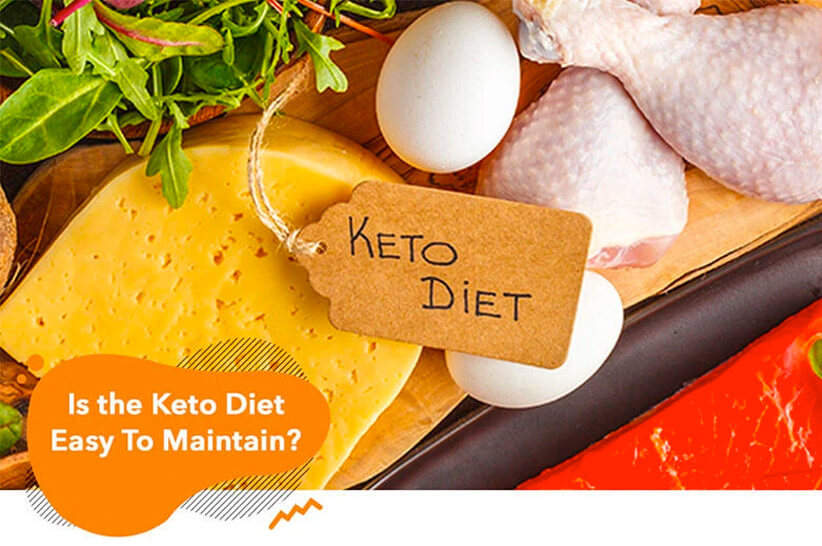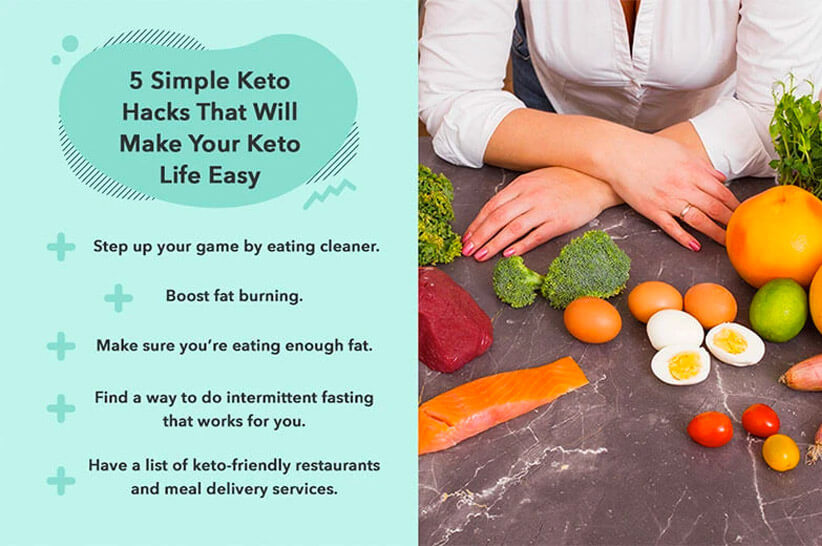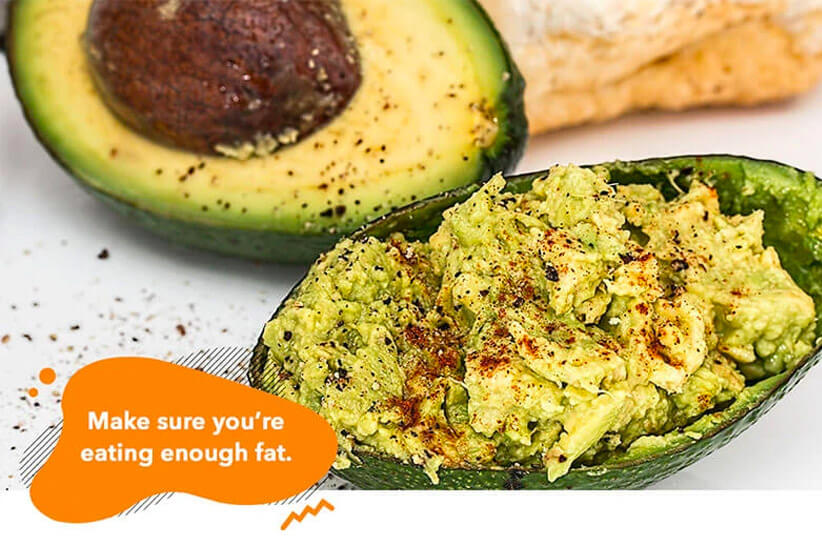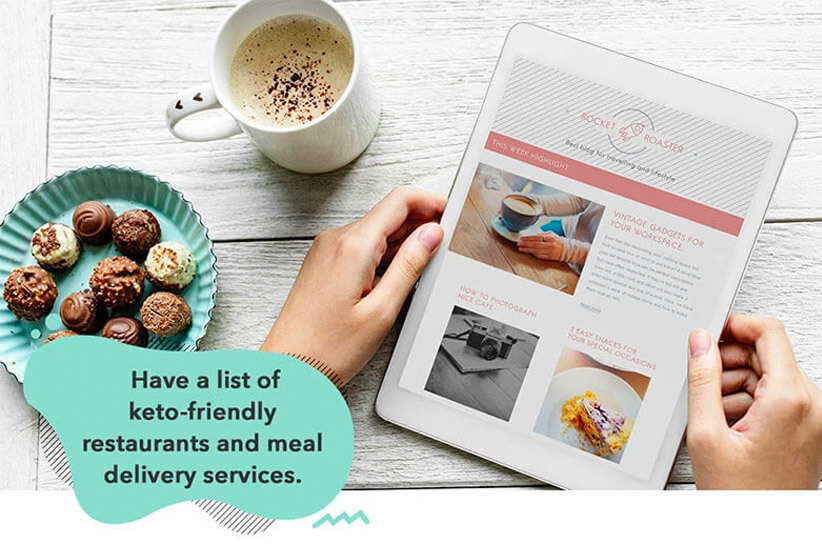Some people start off strong with their keto diet. But as time goes by, their willpower decreases and they no longer see results. There are also those who struggle to follow the keto diet right from the start even if they completely know its benefits. Regardless of your situation, learning some clever keto hacks will help you stay on track.
In today’s blog post, we share five essential hacks on the keto diet, from ditching crappy foods to overcoming a plateau. Let’s get started immediately. Keep reading.
How Do I Get Started on the Keto Diet?
You probably already know what the ketogenic diet is all about. It’s a healthy approach where you keep your carb consumption very low and boost your fat intake.
Because our bodies are so used to getting energy from carbohydrates, depriving your body of carbs depletes glycogen stores and forces it to turn to its alternative fuel source: ketones 1.
While most people choose to follow the keto diet because of one of its most popular benefit, which is weight loss, the keto diet has so much more to offer. The keto diet can boost and stabilize your endurance levels, mental clarity, gut health, energy, and mood. Aside from these things, it also helps prevent a lot of diseases from happening or at least keep them from progressing 1.
Now, let’s answer the most important question: How do you kickstart a keto diet if you haven’t yet? Heed these tips:
- Know what foods to eat and avoid – Research the foods that contain minimal to no carbs and ramp up fat intake. Steer clear of those with higher amounts of sugar (especially hidden sugar). It will help you also to follow a solid meal plan that will provide you with two weeks of ideas as well as a grocery shopping list.
- Calculate your optimal macros – One of the best ways to enter ketosis is to figure out your personal macros. While the general rule of limiting carbs to 20g to 50g per day is good, it’s more effective to know the exact amount of carbs, fat, and protein you should consume. Doing this can help you to meet your goals faster.
- Read keto books and resources – Anyone planning to lead a keto lifestyle will benefit by reading more. Keto Clarity by Jimmy Moore and The Ketogenic Bible by Jacob Wilson are extremely helpful books that will increase your understanding and clear up misconceptions about the diet.
Is the Keto Diet Easy to Maintain?
Many people think that the keto diet is “too difficult” to maintain for the following reasons. It’s possible that they…
- Don’t enjoy doing it
- Take too many steps at once (which lead to a feeling of overwhelm)
- Lack a sense of accountability
- Give in to temptation out of habit
- Give up in disappointment
The truth is that it’s easy to maintain a ketogenic lifestyle if you arm yourself with the right strategies. There will always be simple, less painful, and more enjoyable ways of doing the keto diet. You don’t have to stress yourself, break the bank, or suffer from a bad habit spiral. Start with our five hacks below.
5 Simple Keto Hacks That Will Make Your Keto Life Easy
Achieve more results and fewer side effects with these tips:
1. Step up your game by eating cleaner.
Always keep this in mind: Just because a food is considered keto-friendly, doesn’t mean it’s healthy for you long-term. There are individuals who start a keto diet by doing it the “dirty” way.
In case you don’t know what dirty keto is, it’s a new way of stimulating ketosis by simply paying attention to one’s macros without considering the quality of foods these macros come from. As long as something is low-carb and high-fat, it’s good to go.
We’re not saying that dirty keto is bad. Please don’t take it the wrong way! In fact, someone who’s coming from a Standard American Diet will get amazing results with dirty keto. That’s because his diet now is way better than his previous high-carbohydrate diet.
By all means, do what represents an improvement for you.
However, if you’ve been doing dirty keto for months and are no longer experiencing the results you had when you first started, then it’s high time you step up your game.
Real and unprocessed foods such as meat, fish, and seafood, and as well as above-ground vegetables support optimal health long-term.
They contain more micronutrients antioxidants that support hundreds of processes in the body and prevent cell damage. Examples of these micronutrients and antioxidants include vitamin C, zinc, copper, selenium, beta-carotene, and vitamin E 2.
Here are simple tips to start eating cleaner on the keto diet today:
- Remember that if it spoils easily, it’s better for you. Natural foods don’t contain chemicals and additives. While they improve the freshness and flavor of food, they contain more calories and a higher glycemic load that increase your risk for obesity 3. Additives may also put you at risk for certain cancers.
- Choose grass-fed beef. It’s no secret that beef is one of the staple foods on a keto diet. In addition to avoiding or limiting your intake of unprocessed beef, consider buying grass-fed beef. Grass-fed cattle have a cleaner diet and with that, they contain more conjugated linoleic acid (CLA). Studies show that CLA helps burn body fat and increase muscle mass 4.
- Do whole food swaps. Instead of eating rice, eat cauliflower rice. Instead of using bread crumbs for coating meat, use ground almonds. Instead of getting a bottled drink to quench your thirst, prepare a homemade keto-friendly drink from real lemons.
2. Boost fat burning.
After experiencing a significant weight loss, many keto dieters find themselves dealing with the dreaded weight loss plateau. It usually happens after your glycogen stores have shrunk during the first few weeks of the keto diet.
However, it’s important to also realize that there’s a whole lot of factors that impact your weight loss. Burning more fat isn’t as simple as restricting calories, exercising longer, or eating less! Your hormones play a role. Your lifestyle choices play a role.
To break the plateau and get closer to your weight goal, follow these pieces of advice:
- Be careful of hidden carbs. Snack foods, store-bought salad dressings, sauces, and deli meats may contain hidden forms of carbohydrates. Therefore, carbohydrates often creep into your keto diet when you consume these foods and condiments. Read food labels to find out the total amount of carbs you’re getting per serving, make whole and fresh foods your priority, and cook at home as much as possible to prevent consuming hidden carbs.
- Get better sleep at night. Poor quality sleep or sleep deprivation can hinder weight loss by affecting your hunger and appetite hormones. A study that involved 1,024 volunteers who underwent nocturnal polysomnography showed that short sleep led to elevated ghrelin, the hunger hormone 5. You’re more likely to crave sugar and unhealthy foods with poor sleep. Not to mention that poor sleep also affects your mental and physical performance. You’ll easily feel exhausted and may not be able to complete your workouts if you don’t sleep enough 6.
- Learn how to manage and reduce stress. There are a lot of things that cause stress and anxiety in this modern age. You might not realize that your stressful career or coping mechanism to stressful events is the one hindering fat loss on the keto diet. Try positive ways of dealing with stress such as journaling, meditation, or taking days off from your work or to-do list.
- Switch up your workout routine. When you’re experiencing a weight loss plateau, consider shocking your muscles with a new routine. An exercise will eventually reach a point of diminishing returns because your body has already gotten used to it. Even doing a shorter but more intense workout can work wonders.
3. Make sure you’re eating enough fat.
Decreasing your carbohydrates and not paying attention to your fat intake is probably the reason why your keto diet isn’t working. It’s a mistake not to eat enough fat on the keto diet. Increasing your fat consumption, healthy fat to be specific, has the following benefits:
- Prevents an increase in your appetite – Increasing dietary fat along with decreasing carbohydrates stimulates ketosis. Ketosis burns body fat and helps you to feel less hungry. A study showed that ketogenic low-carbohydrate diets (KLCD) prevent an increase in appetite due to ketosis 7.
- Boosts cognition – Omega-3 fatty acids enhance memory in the elderly. Studies conducted on rodents show that these fatty acids improve cognition in traumatic brain injury. They’re also used as one of the strategies to help patients with mood disorders 8.
- Increases HDL levels – High-density lipoprotein (HDL) is good for your heart because it removes plaque that builds up in the walls of your arteries. HDL also possesses antioxidant and anti-inflammatory properties 9.
Fortunately, there are tons of simple, fun, and delicious ways to eat more healthy fats on the keto diet. They include the following:
- Cook with fat. No matter what keto-friendly food you’re cooking, be sure to use keto-approved oils such as extra virgin olive oil, butter, and avocado oil. If you’ve been using vegetable oils such as corn oil and canola oil, it’s time to replace them. It’s unfortunate that vegetable oils are often advertised as healthy when in reality, they impair fat metabolism and increase heart disease risk 10.
- Eat snacks with plenty of fats. If you need to fuel yourself before or after a workout or are traveling, it’s good to have keto-friendly snacks available. Hard-boiled eggs, tuna-stuffed avocados, and fat bombs are awesome keto-friendly snack options.
- Blend fat into your morning coffee. Bulletproof coffee is the way to go for a morning fat boost on the keto diet. To make it, simply add grass-fed butter or ghee and 1 tablespoon of MCT (medium-chain triglycerides) oil into your cup of brewed coffee.
- Choose fattier cuts of meat. Meat portions that contain higher levels of fat can help you achieve ketosis. The next time you go grocery shopping, purchase one or more of these fatty cuts of meat to up your fat intake for the day: pork belly, chicken thighs, lamb chops, or rib-eye steak.
4. Find a way to do intermittent fasting that works for you.
If you aren’t familiar with intermittent fasting (IF), it’s an eating schedule where you go without food for long periods of time. A lot of people on the keto diet, even celebrities, are doing intermittent fasting for a good reason: to boost results of the keto diet.
Studies conducted on animals reveal that intermittent fasting improves biomarkers of disease, preserves learning and memory, and reduce oxidative stress. Also, intermittent fasting reduces your overall calorie intake provided that you don’t end up overeating during non-fasting periods 11.
While a person may know the benefits of IF, he can most likely struggle to do it successfully because of a busy schedule, food temptations at work, or other reasons.
The key to stay compliant on an IF keto diet is to find a type of intermittent fasting that matches your lifestyle and current fat adaptation state so that it’ll be easier for you to sustain it. The good news is that there are a bunch of ways to fast intermittently. Here are some options:
- One Meal A Day (OMAD). Spend 1 hour of the day consuming a huge keto-friendly meal and spending 23 hours for fasting. What you’ll love about OMAD is that you’ll be able to take the time off from planning your meals for the day. It’s all about simplicity and convenience. Please note that OMAD as an intermittent fasting method may not be suitable to patients with GERD or IBS since it may trigger digestive symptoms. These patients need to eat smaller meals that are spread throughout the day.
- Alternate-Day Fasting (ADF). With this IF approach, you’re going to cycle between days of fasting and eating. Some people don’t respond well to ADF because they have an existing health condition that requires them to eat daily or dislike the idea of going for a day without any food at all.
- Spontaneous Meal Skipping. The most convenient option is to skip a meal if you don’t feel hungry at all or are extremely busy to cook. You can skip dinner and go straight to bed or you can skip breakfast and spend the early hours of the morning performing an important task or a workout to keep you distracted from thinking of food.
- 16/8 Intermittent Fasting. With this method of IF, you’re going to fast for 16 hours and eat within the 8-hour time period. For example, eating between 9:00 am to 5:00 pm and fasting until the next day. That way, you can enjoy a hearty breakfast, join office lunches, and sleep comfortably at night. Consider eating a light snack or dinner before 5:00 pm.
Every keto dieter has personal preferences when it comes to intermittent fasting, which is why you should experiment and stick to what you’re comfortable with.
5. Have a list of keto-friendly restaurants and meal delivery services.
Sometimes, cooking your own keto-friendly meals at home isn’t possible. You might also be going on a vacation. One of the best things about going keto is that alternatives are within reach. These alternatives are much better than having nothing at all which forces you to eat “crappy carbage.”
The solution is to arm yourself with a list of restaurants and meal delivery options that give you access to low-carb and high-fat foods. We recommend that you research a restaurant or meal delivery service beforehand so that you’ll know what to order.
When placing your order, ask for extra non-starchy vegetables on the side. If you’re going to a burger restaurant, remove the buns and enjoy some bacon on top. If you’re having a salad, make a request to remove the dressing and fruit.
What about drinks? While water is undoubtedly the best, you can have unsweetened iced tea, unsweetened coffee, or hot tea with lemon.
As you can see, there are plenty of ways to customize your meals to make them more keto-friendly. Eliminate, replace, and add if needed. So no matter your reason for not being able to cook at home, you won’t have to worry about getting out of ketosis.
Conclusion
The keto diet doesn’t have to drive you crazy or make you quit. By using our five hacks, you’ll be able to stay on track and get maximum results. Remember that there’s a solution for every situation, whether it’s a lack of time, improving the quality of your diet, plateau, or meeting your fat intake goals.
Takeaways
- The keto diet offers a ton of benefits such as weight loss, improved endurance, increased mental clarity, disease prevention, and more.
- You can get started on keto by knowing which foods to eat and avoid, figuring out your personal macros, and reading keto books and resources.
- Eating a cleaner keto diet includes strategies such as making whole food swaps and choosing grass-fed beef.
- Help your body burn more fat by watching out for hidden carbs, getting quality sleep at night, dealing with stress better, and changing your workout routine.
- Consume more healthy fat by cooking with keto-friendly oils, adding butter and MCT oil to your brewed coffee, and eating fattier cuts of meat.
- Follow an intermittent fasting routine and choose the type of IF that’s easiest for you to sustain depending on your lifestyle.
- Whenever you’re too busy to cook or if you’re traveling, have healthy meals delivered or order keto-friendly dishes at a restaurant. Make modifications on such meals if needed to make them keto-friendly.


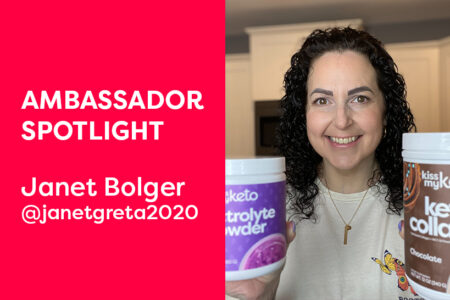

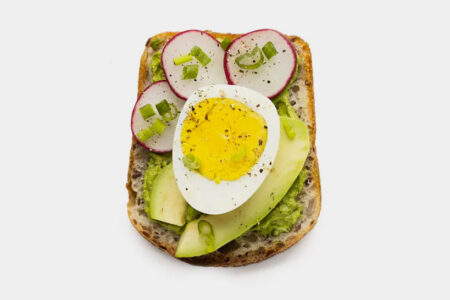
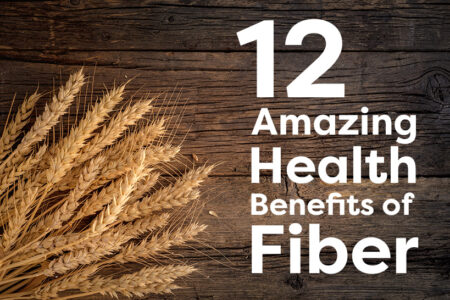




![Juicing for Weight Loss: Everything You Need to Know [Plus Recipes]](/wp-content/uploads/2019/08/Juicing-for-Weight-featured-image.jpg)


